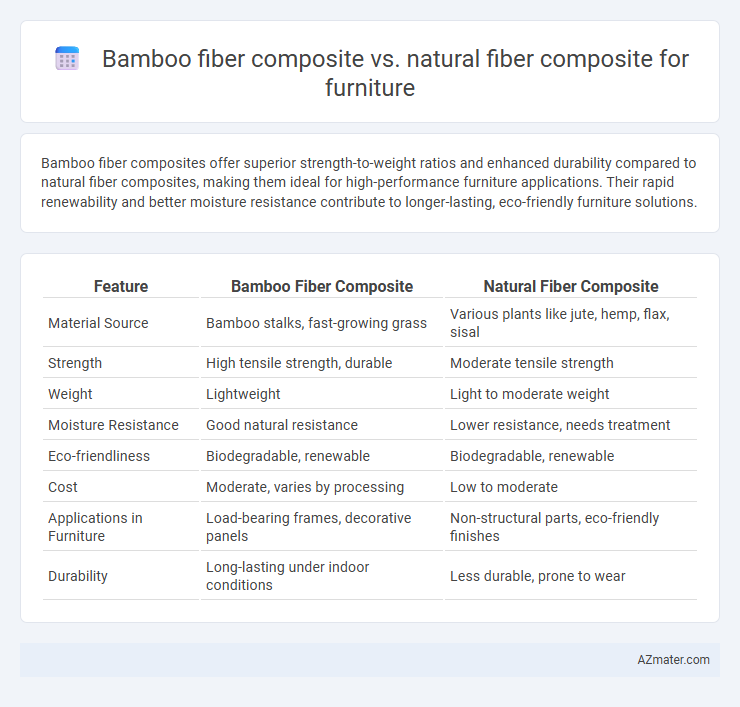Bamboo fiber composites offer superior strength-to-weight ratios and enhanced durability compared to natural fiber composites, making them ideal for high-performance furniture applications. Their rapid renewability and better moisture resistance contribute to longer-lasting, eco-friendly furniture solutions.
Table of Comparison
| Feature | Bamboo Fiber Composite | Natural Fiber Composite |
|---|---|---|
| Material Source | Bamboo stalks, fast-growing grass | Various plants like jute, hemp, flax, sisal |
| Strength | High tensile strength, durable | Moderate tensile strength |
| Weight | Lightweight | Light to moderate weight |
| Moisture Resistance | Good natural resistance | Lower resistance, needs treatment |
| Eco-friendliness | Biodegradable, renewable | Biodegradable, renewable |
| Cost | Moderate, varies by processing | Low to moderate |
| Applications in Furniture | Load-bearing frames, decorative panels | Non-structural parts, eco-friendly finishes |
| Durability | Long-lasting under indoor conditions | Less durable, prone to wear |
Introduction to Fiber Composites in Furniture
Bamboo fiber composites offer superior strength-to-weight ratios and enhanced durability compared to many natural fiber composites, making them ideal for modern furniture applications. Natural fiber composites, such as those made from hemp, flax, or jute, provide eco-friendly alternatives with favorable acoustic and thermal insulation properties, yet often require additives to improve mechanical performance. The choice between bamboo fiber and natural fiber composites hinges on factors like environmental impact, cost efficiency, and desired furniture aesthetics.
Overview of Bamboo Fiber Composites
Bamboo fiber composites combine bamboo fibers with polymer matrices, offering high tensile strength and excellent durability for furniture applications. These composites provide a lightweight yet sturdy alternative to traditional materials, with natural resistance to moisture and pests. Their eco-friendly nature and rapid renewability enhance sustainability in furniture manufacturing compared to conventional natural fiber composites.
Overview of Natural Fiber Composites
Natural fiber composites, made from renewable fibers such as jute, flax, hemp, and sisal, offer sustainable alternatives to synthetic materials in furniture manufacturing, providing lightweight and cost-effective solutions with good mechanical properties. These composites exhibit excellent biodegradability, reduced environmental impact, and enhanced aesthetic appeal due to their natural texture and finish. Challenges include moisture absorption and lower durability compared to synthetic composites, which can be mitigated through surface treatments and hybridization techniques.
Mechanical Properties Comparison
Bamboo fiber composites exhibit superior tensile strength and impact resistance compared to many natural fiber composites like jute or flax, making them ideal for high-load furniture applications. The high cellulose content and dense lignin matrix in bamboo fibers contribute to enhanced stiffness and durability, outperforming natural fibers that often suffer from lower modulus and moisture sensitivity. Additionally, bamboo composites show better dimensional stability and resistance to fatigue, ensuring longer lifespan and structural integrity in furniture manufacturing.
Environmental Sustainability and Eco-friendliness
Bamboo fiber composites exhibit superior environmental sustainability compared to natural fiber composites due to bamboo's rapid renewability and high carbon sequestration capacity. The use of bamboo fibers in furniture production reduces reliance on synthetic materials, lowering the overall carbon footprint and promoting biodegradability. Natural fiber composites, while eco-friendly, often involve slower-growing plants, resulting in a comparatively higher environmental impact during cultivation and processing.
Cost Analysis and Market Availability
Bamboo fiber composites generally offer a lower cost advantage compared to natural fiber composites due to faster growth rates, higher yield per acre, and more efficient processing methods, making them economically attractive for furniture manufacturing. Market availability of bamboo fiber composites is expanding rapidly in Asia and increasingly in Europe and North America, driven by sustainable material demand, while natural fiber composites, such as jute or hemp, face more limited and region-specific supply chains. Price stability and scaling potential favor bamboo composites, positioning them as a competitive alternative to diverse natural fiber composites in the global furniture market.
Durability and Lifespan in Furniture Applications
Bamboo fiber composites exhibit superior durability and a longer lifespan compared to natural fiber composites in furniture applications due to their high tensile strength and resistance to moisture and pests. Natural fiber composites, while eco-friendly, tend to degrade faster under environmental stress, leading to reduced structural integrity over time. The enhanced mechanical properties of bamboo fiber composites ensure sustained performance and lower maintenance costs in furniture manufacturing.
Aesthetic and Design Versatility
Bamboo fiber composites offer a smooth, uniform texture and a rich, natural grain that enhances aesthetic appeal while allowing precise molding for intricate furniture designs. Natural fiber composites, such as flax or hemp, provide a rustic, organic appearance with unique patterns but may exhibit variability in texture and color, impacting uniformity. Both materials enable eco-friendly designs, yet bamboo fiber composites deliver superior consistency and design versatility for modern, sleek furniture styles.
Processing and Manufacturing Techniques
Bamboo fiber composites benefit from rapid growth rates and possess high tensile strength, making them ideal for eco-friendly furniture production through processes like resin infusion and compression molding that enhance durability and surface finish. Natural fiber composites, incorporating fibers such as hemp, jute, and flax, require specialized treatments like alkali or silane treatment to improve fiber-matrix adhesion, and common manufacturing techniques include compression molding, injection molding, and extrusion to balance strength and lightweight properties. Both materials demand optimized processing parameters to control moisture content and fiber orientation, ultimately resulting in sustainable, high-performance furniture components.
Future Prospects and Industry Trends
Bamboo fiber composites exhibit superior strength-to-weight ratios and rapid renewability, positioning them as a highly sustainable option for future furniture manufacturing. Emerging industry trends emphasize eco-friendly materials, driving increased adoption of natural fiber composites with enhanced durability through advanced resin technologies. Market forecasts predict significant growth in bamboo fiber composite usage due to consumer demand for biodegradable products and stringent environmental regulations promoting green construction materials.

Infographic: Bamboo fiber composite vs Natural fiber composite for Furniture
 azmater.com
azmater.com